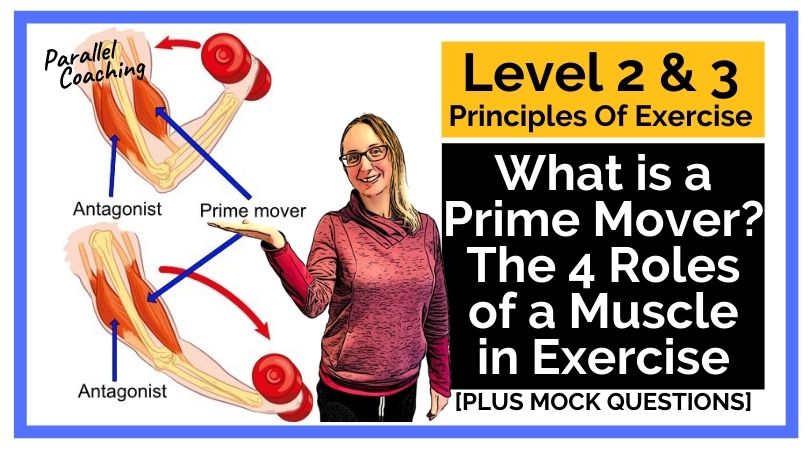Have you ever wondered what is a prime mover? In simple terms, it’s the muscle that we use to perform an exercise.
In this blog and video, we will discuss all four roles of muscles, and how they are used in every exercise we perform. You’ll also learn examples of prime movers and watch an 8-minute video to help you understand how they work together.
Why do I need to know the 4 Roles of a muscle?
You will need to understand each of these terms for your Level 2 and Level 3 anatomy exam. You can expect 3-8 questions that relate to understanding the terminology, the role in exercise and relating it to example movements
- Fixators
- Prime Mover
- Synergist
- Antagonist
Knowing the four roles of a muscle will help you to plan effectively for your client’s workout routine.
As a FITPRO or personal trainer, you need to know the four roles that muscles play in order to make sure your clients are targeting the relevant muscle groups in a workout.
You will need to know these terms so that you can understand which exercises target the prime movers of each muscle group and which ones target synergists or antagonists. You should also be aware of how one exercise can affect the other muscle groups.
WATCH: What are the Four Roles of Muscles in exercise?
Let’s take an in-depth look at each of these roles so that you know which muscles to target during workouts.
What is a Prime Mover?
Prime movers are also commonly called “agonist” or “motor” muscles, since they initiate movements and provide the primary force for that motion.
These are muscles used to perform exercises AND provide the dominant force and motion in movements. These muscles are in charge of contracting and shortening to create the desired force for motion, such as drawing your arm up against gravity.
What is an Antagonist?
the antagonist is the OPPOSITE muscle to the Prime mover. Using the law of reciprocal inhibition the antagonist relaxes whenever the prime mover is contracted. The job of an antagonistic muscle group is to relax while its opposing partner contracts and vice versa, ensuring that there’s always an equal counterweight for movement.
What is a Synergist?
These muscles move in “synergy” with the prime mover. They coordinate with the prime mover to stabilize and control movement, such as stabilizing your shoulder during a bicep curl.
What is a Fixator?
Fixators are often used in conjunction with prime movers or synergists because they can stabilize joints while other muscles contract.
What is the Prime Mover in a Press-up?
The prime mover of the press-up is your Pectoralis Major (chest muscles), which contract and shorten to push you up. If these are weak then it will be hard to maintain the correct form and may lead to injury in other muscle groups.
The antagonist muscle of a press-up is the opposing muscle group, which lengthens to counteract the prime mover. In this case, it is the Trapezius and Rhomboids (the upper back).
The synergist muscle group for a press-up are those that assist the movement. In this case, it is the Triceps Brachii (the back of the arm) and the Anterior Deltoid (front of the shoulder). These muscles assist in lifting the body up and over.
The fixator muscle is also used during a press-up and this is the Latissimus Dorsi (or more commonly known as your “lats”). They are responsible for stabilizing your scapula, therefore keeping it still so that other muscles can contract. This ensures that joints like those found in the shoulder, neck. Other fixators of a press-up include the inner core unit and the glutes and shoulder muscles to maintain the suspended press-up position.
Test your knowledge with 3 Mock Questions
Look at the three Anatomy and Physiology Mock questions below and jot down your answer on scrap paper or as a note in your phone.
Then scroll down to reveal the answers.
1) Which of the following best describe a Prime Mover?
A. The muscle that is relaxed and lengthened
B. The muscle that shortens on the eccentric phase
C. The muscle that generates the dominant force
D. The muscle that keeps one joint still to allow for movement at another joint
2) What is the Antagonist muscle in a Biceps Curl?
A. Biceps Brachii
B. Triceps Brachii
C. Biceps Femoris
D. Brachioradialis
3) What role does the Trapezius play in a Press up?
A. Fixator
B. Prime Mover
C. Synergist
D. Antagonist
Answers:
Q1: Answer = C
Q2: Answer = B
Q3: Answer = D
If you want more mock questions like this, then you can download more Free Mock Questions: DOWNLOAD NOW
Need More Help with your Level 3 Anatomy Revision?
For Trainee FITPROS Taking Their L3 Anatomy & Physiology Exam.
Learn, Revise & Pass Your Level 3 Anatomy & Physiology Exam In Under 10-hours
(Without Having To Spend Hours Revising Or Feeling Overwhelmed)
If you want to get your revision structured, learn everything you need to know, and feel confident on exam day, then click the link below:

Dedicated to More
Hayley “What Is A Prime Mover Muscle 4 Roles That Muscles Play When We Exercise” Bergman
Parallel Coaching
P.S. You can also find us on the following platforms:
Instagram: Follow Now
Facebook: Like Our Page
Twitter: Tweet Us
YouTube: Subscribe Here
More Muscles Blogs: HERE

